"What is a Caspian Gull?" is one of the more frequent questions coming in to BirdGuides. Back in 1982, when Peter Grant produced his seminal book Gulls: a Guide to Identification (revised edition 1986), which was really the starting point to modern gull identification, there was just the Herring Gull. There were Herring Gulls with pink legs and others with yellow legs, and that was about it. Of course Grant recognised that the southern forms were different subspecies, but he did not cover the more easterly birds in any detail. It was Ronald Klein who, before 1994, first discovered that some of the thousands of coloured and metal rings that he read on German landfill sites came from the Ukraine. He further noticed that these birds had a very distinctive appearance. Martin Garner was the first person to rumble these birds in the UK, not by reading rings, but by recognising them from their appearance. This he reported in his 1997 British Birds papers on "Identification of Yellow-legged Gulls in Britain". Of course when he wrote these papers, the name "Yellow-legged Gull" was ambiguous.
It was already well known that yellow-legged "Herring Gulls" from the Mediterranean moved north after the breeding season, but now birds from further east were doing the same - and they looked different. For a start, they didn't have yellow legs - but still they were all called Herring Gulls. To this day, field guides have not moved far beyond this position, and those that have do not give adequate treatment to these birds. Indeed the name "Caspian Gull" does not appear in any of them! To be fair, most of the progress in taxonomy and identification has happened after they were due at the printers.
Various names have been used for these birds, including Steppe Gull and Pontic Gull, but since Lars Jonsson's paper in Alula, Volume 4 3/98 "Yellow-legged Gulls and yellow-legged Herring Gulls in the Baltic" in which he presented reasoned arguments against the use of these names, the name Caspian Gull has gained widespread acceptance.
There is now increased clarity on the taxonomy of "large white-headed gulls" and it seems there are between 8 and 10 species knocking about between Europe and Asia. The clearest and most recent summary of all this is by Pierre Yesou, Dutch Birding Vol 24, No 5, 2002, "Systematics of Larus argentatus-cachinnans-fuscus complex revisited".
Most taxonomists seem finally to have agreed what mere birders have suspected for some time: that what was the Herring Gull in Europe is actually 3 good species, but at the time of writing, the BOURC has yet to agree, so the position of Caspian Gull and Yellow-legged Gull for the UK lister is still ambiguous.
The pink-legged gulls of Britain and other northern countries are still called Herring Gulls Larus argentatus, the yellow-legged ones from the Mediterranean, the Atlantic coast of Iberia, Morocco and the Atlantic Islands are called Yellow-legged Gulls Larus michahellis and the ones that have pale pink or pale straw-coloured legs, and which breed north of the Black Sea, in the Ukraine and east of there, are called Caspian Gulls Larus cachinnans.
Both Yellow-legged Gulls and Caspian Gulls have been moving north and northwest in recent years, and some Caspian Gulls have remained to breed in Poland and eastern Germany, a minority in mixed pairs with Herring Gull and Yellow-legged Gull. Where their breeding ranges overlap, Yellow-legged with Herring Gull in western France and Yellow-legged with Caspian Gull in Romania, there are far more pure than mixed pairs.
More good news is that the majority of individuals of these three species are quite easy to identify at all ages (but some are tricky). Now "quite easy" is a relative term. One has to go through some pain and dedication before getting to this level of confidence.
The normal sequence that intending gull-watchers go through is to find one or two Yellow-legged or Caspian Gulls of their own. They then realise how "easy" it all seems to be, and so wonder what the fuss was about. They then get something horribly wrong in front of their peers, suffer embarrassment and humiliation (in their mind) and become somewhat disillusioned about the whole thing. This is a cyclical process, which proceeds by correctly identifying more and more gulls, interspersed with cock-ups. I have been there, got the tee-shirt, book and seen the film and I still get it wrong sometimes. The seasoned gull-watcher has a very healthy respect for the problem, but if you don't make public mistakes, then you are not trying hard enough!
So why is it so hard? It is because they are gulls and no matter what rules you try, some individuals will always break them. Large gulls are incredibly variable because of a number of factors including age differences, racial differences, moult timing differences, amount of exposure to sun, to name a few.
The seasoned gull-watcher also wonders today how it was that such a cracking and distinctive gull as Caspian Gull was overlooked for so long – both by taxonomists and by birdwatchers. This is because, regrettably, things that are taxonomically lumped are considered less interesting and so receive less attention than those that are split. Also, it is believed that, as in the case of Mediterranean Gull, these birds have only been coming north and west in more recent decades.
Finding and identifying a Caspian Gull
It is a disappointing day if, in southeast England, in winter at least, a day's gull-watching at a landfill or a reservoir roost does not produce a few Yellow-legged Gulls and at least one Caspian Gull. Caspian Gulls outnumber Glaucous and Iceland Gulls together in our neck of the woods.
The easiest ages to pick out are 1st-winters and adults. There are enough of these around to make it well worth looking for them. So these are the only two ages that we will deal with here. This is not intended to be a definitive identification guide, so we will only describe the most typical birds - but, being gulls, there is considerable variation.
Imagine trying to tell the difference between Yul Brynner and Telly Savalas from a written description – far better to see some pictures of these two follically challenged gents. So the first step is to get some idea of what you are looking for. Fortunately, there are enough websites around with a wide range of pictures of Caspian Gulls to give one an idea. A good place to start is Rudy Offereins' site, which has a comprehensive index to other gull sites, as well as an excellent collection of pictures of Caspian Gulls:
http://www.xs4all.nl/~calidris/gullindex.htm
Birding World magazine, Vol. 13, No. 2, February 2000; also has a very good collection of pictures: "Caspian Gull Identification Gallery" by Theo Bakker, Rudy Offereins and Rik Winters.
What is the first thing that hits you while scanning a large flock of gulls and shouts Caspian Gull at you? Usually, whatever the age, it is its face: a gleaming white head, a small beady eye, and a long (sometimes very long), snouty, slender bill. Any adult "herring gull" during October to November with a pure white head is worth a second look, and this can be a useful indicator into December too (this also applies to Yellow-legged Gull). By the turn of the year it is becoming less useful as Scandinavian Herring Gulls (argentatus), with a similar shape, become white-headed too.
What is the list of things that you should check out when you think you have found a likely candidate?
The canonical 1st-winter Caspian Gull looks like this:
- A white head nestled in a "shawl" of dark streaks around the hind neck.
- A variable amount of "eye shadow" and an indistinct line from eye to eye across the nape.
- A long, narrow, parallel-sided bill attached to a gently sloping forehead – sometimes recalling a huge Slender-billed Gull.
- Uniform, dark, unpatterned greater and median coverts, with whitish tips. This gives the impression of uniformly dark greater coverts bordered by two parallel white lines. Some birds can have patterned greater coverts, especially on the inner ones (near the tertials).
- White underwing and axillaries – really concentrate when the wings are raised! (white underwings in older birds are less relevant)
- A pale panel on the inner primaries caused by pale, translucent inner webs, more obvious than Yellow-legged Gull.
- Scapulars with pale greyish bases and with narrow single anchors with a thin dark shaft, or small triangles, or no anchors and just a thin shaft streak. The scapulars contrast paler than the wing coverts. There is a three-way contrast of grey mantle, brown wings and white body.
- Tertials dark brown with a whitish "thumbnail" on the end of every feather.
- A white tail with a broad even-thickness black tail-band. Any "herring gull" with a black (not dark brown) tail band and a clean white tail-base and rump is promising for Caspian or Yellow-legged Gull.
- A white corridor from the chin, through the breast, all the way to the under tail coverts.
- A characteristic structure: long bill, long neck, long legs, long wings.
- Legs usually long and spindly, especially when viewed from the front or rear, greyish/whitish pink.
Just about all of these rules are broken by individual 1st-winter Caspian Gulls, but if you get a hit on most of them you are probably in with a shout.
The canonical adult Caspian Gull looks like this:
- A smart, elegant, long-winged, long-legged, white-headed gull with a characteristic face.
- A long, slender, parallel-sided bill, often pallid, even limey in colour, attached to a gently sloping forehead.
- A small dark eye (bullet hole) (but 30% of birds have pale eyes).
- Dorsum (= back and wing-coverts) shade darker than British Herring Gull, but lighter than Yellow-legged Gull.
- A large white tip on P10 (outermost primary) and a long white tongue on the inner web of P10 (watch it preening).
- Grey tongues protruding in to the black on the upper-side of the primaries in flight.
- A broad black band on P5 (this is hard to see unless you get a photo or videograb of a stretched wing).
- Long, slender legs, whitish-pink/pale straw (not yellow, but not as pink as Herring Gull)
- Some birds have the appearance of an enormous Common Gull because of their long wings and a lot of white in the wingtip (this impression can be even more marked in some younger subadult birds which have a greenish bill with a black ring).
Again, most of these rules can be broken in perfectly good adult Caspian Gulls.
Apart from its appearance, if you are ever fortunate enough to hear a Caspian Gull call, it is quite remarkable: more like a donkey than a Herring Gull! Whatever the age, its behaviour on landfills is often quite distinctive, being aggressive to other birds, while holding its long wings outstretched like an albatross. They seem to be hyperactive; they wander about a lot; they waddle and seem to have big feet, like a duck; they frequently look for a lost egg between their legs; they peck and jab at other gulls - but note, the others can do some of these things on occasion too, especially michahellis. (Another difference is its breeding habitat: it differs from the other two, preferring low flat islands in lakes rather than cliffs and steep slopes.)
Traps for the unwary:
- Yellow-legged Gull (michahellis) and Scandinavian Herring Gull (argentatus) can sometimes sport a remarkably long bill.
- Michahellis is also very white-headed but normally has a heavier bill, yellower legs and different wing pattern.
- Argentatus Herring Gulls acquire a very white head in the latter half of the winter. They can be a pitfall because they can have a similar shape to Caspian Gull but helpfully they lose their head streaks later than British birds (argenteus) and are unlikely to appear white-headed much before mid January.
- Some adult argentatus Herring Gulls can have a very similar pattern to P10, and a narrow black band or a black mark on the outer web of P5 but are shorter legged.
- Adult argentatus Herring Gulls from the north can be as dark as or darker than Caspian Gulls.
- Both adult argentatus and michahellis can occasionally have a dark-looking iris.
- Some eastern/Finnish adult Herring Gulls can sometimes look similar to Caspian Gull.
- Occasionally, even very white-headed 1st-summer Lesser Black-backed Gulls can look like a Caspian Gull.
As well as misidentifying other species as Caspian Gulls, you can also be put off perfectly good Caspian Gulls because a 1st-winter has patterned greater coverts, or heavily marked scapulars or even a dark underwing. Birds of any age may have a shortish bill, or stout legs or an adult may have a pale eye. With some of these birds you cannot always be entirely certain you have not got one of mixed parentage. It seems likely that Caspian Gulls show as much variability as better-known forms such as Herring Gull, so not all should be expected to conform to the average appearance described above.
Once you have got the hang of 1st-winter and adult Caspian Gulls, you will recognise the look and structure in other ages. You will see very few juvenile birds: they are rare because most have moulted to 1st-winter plumage by the time they reach the UK.
When you find a Caspian Gull (or any unusual gull for that matter), the subtleties of its shape, facial expression and general jizz are difficult to describe verbally, but digiscoping is a great way of getting adequate record shots of gulls to document what you see, and it is far more compelling for your local committee when you submit your records. You can see my own attempts at this here:
http://www.magikcircle.com/birds/image.asp?search=0&title_id=169&show_thumbnails=True
A selection of images appears below. These pictures, and those on the website, demonstrate a wider range of variation than described above, and of course one cannot eliminate the possibility of birds of mixed parentage that may have originated from the mixed colonies in eastern Europe, such as the famous mixed colony at Kleinskochen in eastern Germany. The true range of variation of a pure Caspian Gull is not yet fully understood (at least not by me).
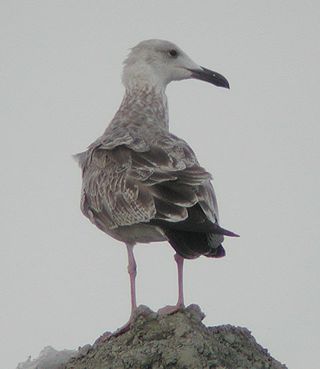
Juvenile, 23rd August 2002: This bird nicely illustrates the characteristic shape, though not all of them have a bill this long. Juveniles are the least common age class seen in the UK.
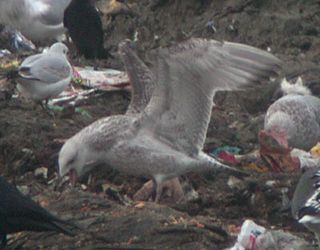
1st-winter, 14th December 2002: Here can be seen the typical
albatross stance and the whitish underwing of a 1st-winter.
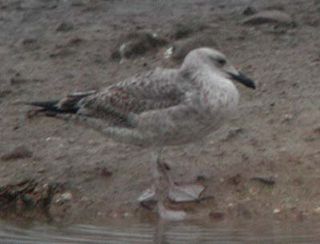
1st-winter, 21st December 2002: This picture illustrates the
big feet and long pale pink legs, the dark greater coverts bordered by two parallel lines, the thumbnail tertials as well as the classic head shape.
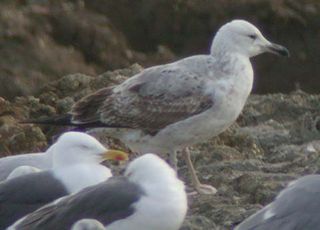
1st-winter, 12th February 2002: This picture illustrates the
three-tone appearance, not quite typical greater coverts, lacking clear white tips, thumbnail tertials and a fairly typical head shape.
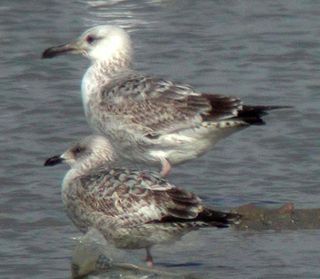
1st-winter, 25th February 2002: This huge bird, almost certainly a male, demonstrates a caricature of a typical Caspian bill. It also shows the white head nestled in a shawl, perfect greater coverts bordered by two parallel white lines and thumbnail tertials.
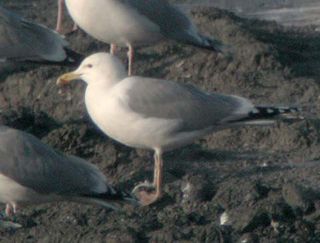
Adult, 11th January 2003: This is a typical adult. Its friendly head, thin bill and long wings recall a huge Common Gull. Other points to note are the limey tone to the bill, the small dark-looking eye and the yellowish-pink legs.
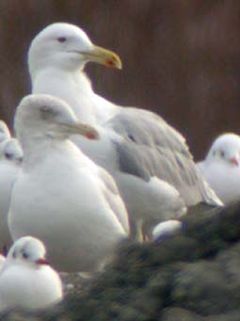
Adult, 29th December 2001: This huge bird, almost certainly a
male, demonstrates the aloof elegance of some Caspian Gulls. It is also very white-headed and has an enormously long bill.
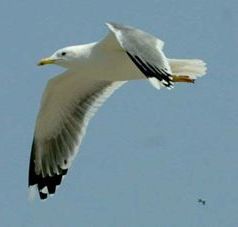
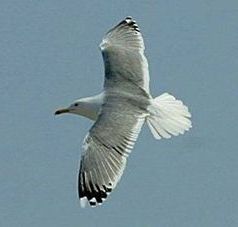
Adult, 2nd March 2002: This bird was taken in Oman, so it is
not quite the same thing that turns up in the UK. However, it nicely
illustrates the upper and under wing pattern: the white tip and tongue on
P10, the grey tongues extending into the black on the upper wing. It differs from typical UK birds in not having a complete black band on P5.
Conclusion
So, in answer to the question: "What is a Caspian Gull?"
- It is an extremely smart distinctive gull.
- It is now recognised as a good species in its own right, Larus cachinnans, different from Yellow-legged Gull Larus michahellis and Herring Gull Larus argentatus.
- It originates from the region north of the Black Sea and eastwards from there to Kazakstan.
- Some birds now breed in eastern Germany and Poland.
- Most birds are easy to identify, but confusing birds occur also.
Peter Grant would have loved what has gone on with gull taxonomy and identification in the last few years. I can recall standing on the shores of the Caspian Sea with him in 1970 and noticing a distant flock of rather snouty-looking "Herring Gulls". For years afterwards I wondered: had we "thrown away" a flock of winter-plumaged Great Black-headed Gulls? I now know that we had not – they were our first Caspian Gulls! Little did I know that, 30 years later, I could go to my local landfill, near Cambridge, and regularly see the same thing.
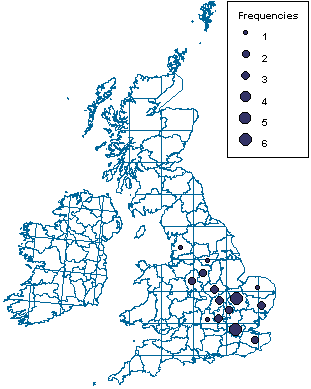
Distribution by county of Caspian Gull reports on Bird News Extra, January 2003
(NB: gulls may range widely and some reports may refer to the same birds in different locations). It is clear that there
is a southeasterly bias to the records, as would be
expected from birds originating from Europe. Away from
the Southeast and Midlands, records remain genuinely rare.
Where to look for Caspian Gulls
The following sites (among others) have recently produced Caspian Gull sightings. Several are traditional haunts of this species.
- Godmanchester, Cambs: several birds of various ages reported since the New Year (TL2571); also in Cambridgeshire birds have been reported at Little Paxton (c. TL1963), Long Drove (Cottenham) and Milton Tip
- Hedgerley Tip, Bucks: a 1st-winter and up to 2 adults recently, often seen from the M40 bridge leading to Hyde Farm (SU959889)
- Dungeness, Kent: up to two 1st-winters reported from 'The Patch' in recent weeks (c. TR085164)
- Dix Pit, Stanton Harcourt, Oxon: an adult reported several times this winter (SP4004)
- Brogborough Lake, Beds: adult, 1st-winter and 2nd-winter birds reported in recent weeks (SP9739)
- Blyth Estuary, Suffolk: a couple of recent reports, often in the vicinity of a traditional site, the White Hart PH at Blythburgh (approx. TM455755)
- Ogston Reservoir, Derbys: an adult in the gull roost on the 15th/16th January (SK3760)
- Welford Tip, Northants: an adult on 25th January at this traditional site south of the A14 near the junction with the A5199 (c. SP6577)
Use the Bird News Extra search page for up-to-date information, and to search for sightings in your area.
Acknowledgements
I am grateful to Chris Kehoe, John McLoughlin, Richard Patient, Bruce Martin and Bob Tonks for helpful comments on early drafts.


